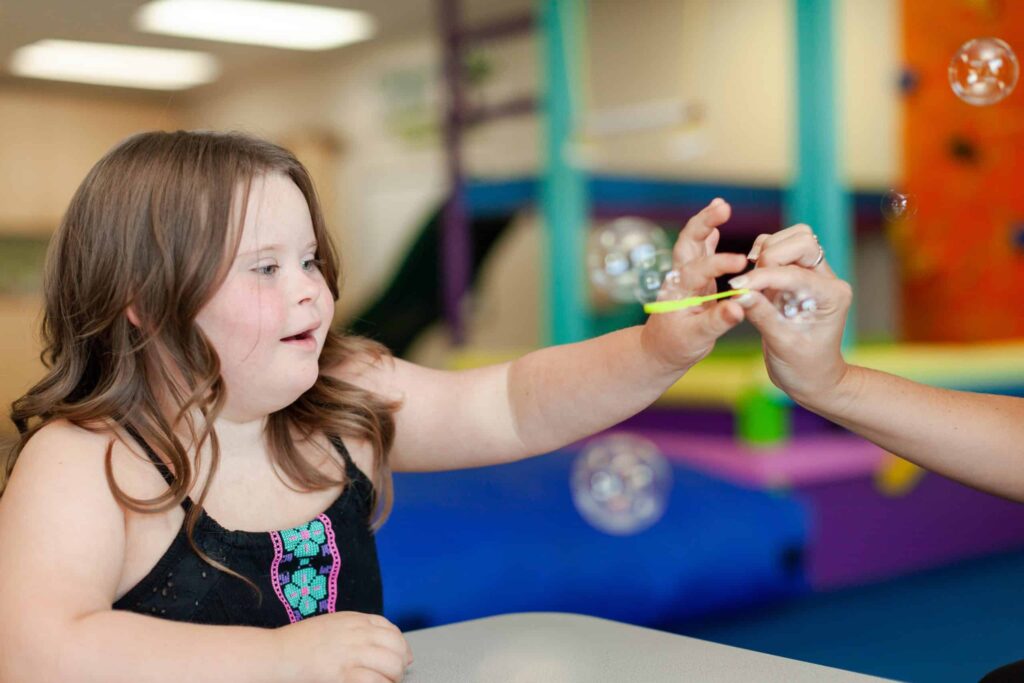Although up to 90% of people with an Autism Spectrum Disorder have sensory processing difficulties, Sensory Processing Disorder is a separate condition recognized in up to 16% of the general population. Keep reading to learn about .
Autism
Autism Spectrum Disorder (ASD) is a lifelong neurodevelopmental disorder estimated to affect 1 in 44 children in the United States, with boys roughly four times as likely to be diagnosed with an ASD compared to girls. The specific diagnostic criteria for ASD are set forth by the American Psychiatric Association. They can be found in the American Psychiatric Diagnostic and Statistical Manual (5th ed.).
A diagnosis of an autism spectrum disorder must include persistent deficits in all three of the following development skills:
- Social communication and social interaction
- Nonverbal communication
- Developing, maintaining, and understanding relationships
As a spectrum disorder, ASD can include various levels of severity, and a wide range of symptoms can occur in social communication or repetitive, restricted patterns of behavior.
Behaviors can be observed as:
- Stereotypic or repetitive behaviors
- Need for sameness
- Restricted or fixated interests and motor movements
- Irregularities or unusual interest in sensory differences and information
Sensory Processing Disorder
Sensory processing is the nervous system’s ability to receive, process, and react to sensory information from one’s own body and the environment. This includes all the sensory systems human beings use to gather information, consciously or subconsciously.
Sensory systems used include:
- Visual, auditory, and olfactory systems
- Vestibular and proprioceptive systems: tell us where our body is in space and how we are moving, the tactile system or touch system
- Gustatory system: tell us what we taste, the temperature and feeling of what we eat
These sensory systems and how the nervous system processes sensory information help us balance how we respond to information and coordinate and organize our body and mind to react appropriately.
Sensory Processing Disorder (SPD) is when sensory information entering the nervous system is incorrectly processed, resulting in a person’s inaccurate reactions, recognition, perceptions, or awareness. Irregularities in sensory processing are typically recognized and acted upon as an oversensitivity or a decreased registration or awareness of sensory information. Sometimes, these irregularities can escalate into sensory overload, where the individual becomes overwhelmed by too much sensory input, significantly affecting their behavior and ability to function normally.
One specific example of such an irregularity is tactile defensiveness, a condition where individuals have an unusually high sensitivity to touch. Those with tactile defensiveness may find certain textures or physical contact unbearable, leading to discomfort, avoidance, or even pain.
Sensory processing symptoms may include:
- Discomfort
- Avoidances
- Inappropriate responses
- Fear
- Shutdown
- Emotional dysregulation
- Refusals
- Cravings
- Stereotypic behaviors
In addition, the disorganization of sensory information can affect how we:
- Coordinate our bodies
- React to the environment
- Perform daily activities
- Interact with others
- Learn
In 2009, a study by Carter et al. suggested that 1 in every 6 children exhibits sensory processing irregularities that may affect their daily abilities and behaviors.
Can you have a sensory processing disorder and not be autistic?
Yes! Although they sound similar, can be present without . Often children or adults with other neurodevelopmental or psychiatric conditions such as Developmental Delay, Intellectual Disability, Anxiety, ADHD, or mood disorders can also exhibit Sensory Processing Disorder. In addition, for children who are gifted and those with ADHD, Autism, and Fragile X Syndrome, the prevalence of SPD is much higher than in the general population. (Miller, L. (n.d.) Children or adults may have sensory processing challenges or disorders independently without other diagnoses.
Sensory processing can be broken down into three main categories:
- Sensory Modulation Disorder: Impedes a person’s ability to regulate their response to sensations. Someone with this pattern of sensory disorder may overreact and underreact to sensory input.
- Sensory Over-Responsivity: More sensitive to sensory stimulation. Their bodies may feel sensations too intensely or easily. These individuals are often in a “fight or flight” state due to their , and they usually try to avoid or minimize sensations.
- Sensory Under Responsivity: Less sensitive to sensory stimulation and often quiet and passive. Individuals that are under-responsive may not notice pain or be able to perceive force.
- Sensory-Based Motor Disorder
- Dyspraxia: Trouble processing sensory information resulting in problems planning and carrying out new motor actions. They may have difficulty forming ideas, planning actions, or performing new motor tasks.
- Postural Disorder: difficulty stabilizing their body during movement or at rest to meet the demands of a motor task.
- Sensory Discrimination Disorder: Difficulty determining the characteristics of sensory stimulus. It is hard for these individuals to detect similarities and differences among stimuli in the sensory systems of visual, auditory, tactile, taste, smell, proprioceptive, vestibular, and interoception.
Can sensory processing disorder be misdiagnosed as Autism?
Because Sensory Processing Disorder and other neurodevelopmental disorders such as Autism Spectrum Disorder share the same neurological networks and brain structures, the behaviors influenced by these processes can mimic each other.
Sensory Processing Disorder includes:
- Irregular processing of sensory information in the brain that can appear as decreased engagement with activities
- Limited interactions with others due to various sensitivities
- Inappropriate behaviors
- Reactions in an overstimulating environment
- Little motor development due to poor body awareness or poor coordination resulting in repetitive motor tasks
- Limited play skills
Sensory Processing Disorder may cause irritability, anxiety, avoidance, or maladapted behaviors in children. These behaviors often mimic the behaviors observed in Autism, particularly in how sensory responses impact social skill development and interaction.
It is important to recognize the specific deficits in social skills, social communication, and the difficulty of developing relationships in children with Autism Spectrum Disorder as the primary deficit. However, this too can be different across the spectrum of sensory symptoms.
As with many neurological conditions, there can be an overlap in how the brain processes information and how an individual develops behaviors in reaction to processing irregularities. Because of these overlapping symptoms, a comprehensive evaluation is needed to make a correct individualized diagnosis for each child.
Ivy Rehab for Kids can Help
Understanding the differences between SPD vs. autism can significantly influence the therapeutic approaches used. While both conditions share some sensory challenges, the nature and implications of these challenges can differ markedly, affecting how therapies are tailored to meet each child’s unique needs.
If you find your child has difficulty engaging or participating in age-appropriate activities of daily living or instrumental activities due to sensory sensitivities or irregularities, please consult your pediatrician. They can provide you with an occupational therapy referral. Occupational therapy for and can be helpful in a ‘s development.
Once the initial evaluation is scheduled, a licensed and registered occupational therapist will evaluate to further understand your child’s specific sensory needs and your concerns. This may include writing up goals that incorporate sensory strategies into your child’s daily life and creating a sensory lifestyle that most benefits your child. may be of great help for your ‘s . Together with you and your child, your occupational therapist will provide information, education, and strategies to increase your child’s optimal level of arousal for increased participation and engagement in age-appropriate activities of daily living and instrumental activities of daily living.
Ivy Rehab for Kids offers pediatric occupational therapy, physical therapy, speech therapy, and applied behavior analysis therapy (ABA) services at select locations.
If you’re wondering if pediatric therapy can help your child, you may request an appointment online or call the location near you.
Article By: Cynthia Preston, OTR/L, M.A.
Cynthia began her pediatric occupational therapy career 30 years ago. Cynthia loves working with the pediatric population and believes in the importance of providing comprehensive evaluation and treatment for children and families with various disabilities. She is currently a Ph.D. student at Fielding Graduate University, writing her dissertation on the Early Symptoms of Pediatric Bipolar Disorder in Children aged three and under. Cynthia has specialized in early intervention, infant and pediatric mental health, infant and early childhood development, and autism spectrum disorders and is certified in the SIPT. While attending graduate school, she currently treats patients at ABC Pediatric Network, Beaver Creek, OH.





